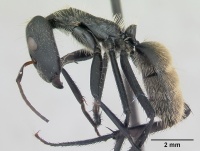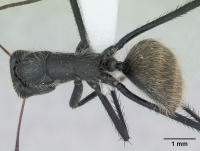Camponotus depressus
| Camponotus depressus | |
|---|---|

| |
| Scientific classification | |
| Kingdom: | Animalia |
| Phylum: | Arthropoda |
| Class: | Insecta |
| Order: | Hymenoptera |
| Family: | Formicidae |
| Subfamily: | Formicinae |
| Tribe: | Camponotini |
| Genus: | Camponotus |
| Species: | C. depressus |
| Binomial name | |
| Camponotus depressus Mayr, 1866 | |
Camponotus depressus selectively nests in dead bamboo occurring from Amazonia, Brazil south to Paraguay (Davidson et al., 2006). This ant is not an obligate bamboo nester. De Oliveira et al. (2015) found a colony opportunistically nesting in a Cecropia saxatilis tree (southwest Bahia, Brazil).
| At a Glance | • Bamboo Specialist |
Identification
Distribution
Latitudinal Distribution Pattern
Latitudinal Range: 25.68015° to -25.92°.
| North Temperate |
North Subtropical |
Tropical | South Subtropical |
South Temperate |
- Source: AntMaps
Distribution based on Regional Taxon Lists
Neotropical Region: Argentina, Brazil (type locality), Paraguay.
Distribution based on AntMaps
Distribution based on AntWeb specimens
Check data from AntWeb
Countries Occupied
| Number of countries occupied by this species based on AntWiki Regional Taxon Lists. In general, fewer countries occupied indicates a narrower range, while more countries indicates a more widespread species. |

|
Estimated Abundance
| Relative abundance based on number of AntMaps records per species (this species within the purple bar). Fewer records (to the left) indicates a less abundant/encountered species while more records (to the right) indicates more abundant/encountered species. |

|
Biology
C. depressus may be tied to dead bamboo because it provides superior nest sites, or by nutritional dependency on prodigious wound exudates produced at sites of insect damage to growing culm tips (Davidson et al., 2006). Such strict reliance on nests in dead bamboo has not been reported in Asian bamboo ants.
Leite et al. (2013) studied the foraging behavior of Celeus obrieni (Kaempfer's Woodpecker), a bamboo specialists that feeds on ants. This field study was conducted in central-western Brazil on the plains of the Araguiai River from 2008-2010. The research focused on foraging by C. obrieni on Guadua paniculata, a large bamboo species, in cerradão habitat. Celeus obrieni are known to forage and breed in patches of G. paniculata. Ants use the hollow stems of the bamboo as a nesting resource.
Leite et al. found the woodpeckers, in comparison with standardized foraging observations on other plants around these same sites, concentrated their foraging on bamboo. A sample of stems (n = 900) that were not visited by the woodpecker showed ~40% contained ant nests. Thirteen ant species were found, with three being common (76% of all nests): Azteca fasciata, Camponotus atriceps, and Camponotus depressus. Most nests for these were located 2-4 m from the ground. Dead stems (59%) contained more nests than live stems. A second set of bamboo stem samples, those foraged on and drilled into by C. obrieni, were also inspected. Drilling was concentrated at the same height where the majority of ant nests were found in the unforaged-stem samples. Despite the much larger proportion of live stems within each stand, more dead (62%) than live stems were drilled. Fifty-nine percent of the drilled stems contained ant colonies. Nests of Camponotus depressus were the most common, Azteca fasciata less frequent, and Camponotus atriceps found in only four of the drilled stems.
Castes
Images from AntWeb
  
| |
| Worker (major/soldier). Specimen code casent0173411. Photographer April Nobile, uploaded by California Academy of Sciences. | Owned by ALWC, Alex L. Wild Collection. |
Nomenclature
The following information is derived from Barry Bolton's Online Catalogue of the Ants of the World.
- depressus. Camponotus depressus Mayr, 1866a: 487, pl., fig. 1 (w.) BRAZIL (no state data).
- Type-material: holotype worker.
- Type-locality: Brazil: (no further data).
- [Note: Forel, 1895b: 102, gives the type-locality as Brazil: Rio de Janeiro, Colonia Alpina.]
- Type-depository: unknown (perhaps MLUH or NHMW).
- [Note: original description gives the depository as “zoologischen Museum in Halle” (MLUH).]
- Menozzi, 1925b: 371 (q.).
- Combination in C. (Myrmomalis): Forel, 1914a: 263.
- Status as species: Dalla Torre, 1893: 228; Forel, 1895b: 102; Emery, 1896d: 377 (in list); Mann, 1916: 481; Menozzi, 1925b: 371; Emery, 1925b: 169; Borgmeier, 1927c: 160; Kempf, 1972a: 57; Brandão, 1991: 333; Bolton, 1995b: 96; Wild, 2007b: 28; Bezděčková, et al. 2015: 112.
- Distribution: Bolivia, Brazil, Paraguay, Peru.
Description
References
- Albuquerque, E., Prado, L., Andrade-Silva, J., Siqueira, E., Sampaio, K., Alves, D., Brandão, C., Andrade, P., Feitosa, R., Koch, E., Delabie, J., Fernandes, I., Baccaro, F., Souza, J., Almeida, R., Silva, R. 2021. Ants of the State of Pará, Brazil: a historical and comprehensive dataset of a key biodiversity hotspot in the Amazon Basin. Zootaxa 5001, 1–83 (doi:10.11646/zootaxa.5001.1.1).
- Davidson, D.W., Arias, J.A., Mann, J. 2006. An experimental study of bamboo ants in western Amazonia. Insectes Sociaux 53, 108–114 (doi:10.1007/s00040-005-0843-8).
- de Oliveira, G. V., M. M. Correa, I. M. A. Goes, A. F. P. Machado, R. J. de Sa-Neto, and J. H. C. Delabie. 2015. Interactions between Cecropia (Urticaceae) and ants (Hymenoptera: Formicidae) along a longitudinal east-west transect in the Brazilian Northeast. Annales De La Societe Entomologique De France. 51:153-160. doi:10.1080/00379271.2015.1061231
- Forel, A. 1914a. Le genre Camponotus Mayr et les genres voisins. Rev. Suisse Zool. 22: 257-276 (page 263, combination in C. (Myrmomalis))
- Leite, G.A., Pinheiro, R.T. et al. 2013. Foraging behavior of Kaempfer's Woodpecker (Celeus obrieni), a bamboo specialist. The Condor 115:221-229. doi:10.1525/cond.2013.120062
- Mayr, G. 1866a. Myrmecologische Beiträge. Sitzungsber. Kais. Akad. Wiss. Wien Math.-Naturwiss. Cl. Abt. I 53: 484-517 (page 487, pl., fig. 1 worker described)
- Menozzi, C. 1925b. Qualche formica nuova od interessante del Deutsch. Ent. Institut di Dahlem (Form.). Entomol. Mitt. 14: 368-371 (page 371, queen described)
References based on Global Ant Biodiversity Informatics
- Arruda F. V., M. A. Pesquero, D. G. Marcelino, G. A. Leiter, J. H. C. Delabie, and R. Fagundes. 2015. Size and condition of bamboo as structural factors behind the vertical stratification of the bamboo-nesting ant community. Insectes Sociaux DOI 10.1007/s00040-015-0440-4
- Bezdeckova K., P. Bedecka, and I. Machar. 2015. A checklist of the ants (Hymenoptera: Formicidae) of Peru. Zootaxa 4020 (1): 101–133.
- Brandao, C.R.F. 1991. Adendos ao catalogo abreviado das formigas da regiao neotropical (Hymenoptera: Formicidae). Rev. Bras. Entomol. 35: 319-412.
- Davidson D. W., S. C. Cook, R. R. Snelling and T. H. Chua. 2003. Explaining the Abundance of Ants in Lowland Tropical Rainforest Canopies. Science 300: 969-972.
- Davidson, D.W. 2005. Ecological stoichiometry of ants in a New World rain forest. Oecologia 142:221-231
- Davidson, D.W., J.A. Arias and J. Mann. 2006. An experimental study of bamboo ants in western Amazonia. Insectes Sociaux 53:108-114
- Kempf W. W. 1978. A preliminary zoogeographical analysis of a regional ant fauna in Latin America. 114. Studia Entomologica 20: 43-62.
- Kempf, W.W. 1972. Catalago abreviado das formigas da regiao Neotropical (Hym. Formicidae) Studia Entomologica 15(1-4).
- Mann W. M. 1916. The Stanford Expedition to Brazil, 1911, John C. Branner, Director. The ants of Brazil. Bulletin of the Museum of Comparative Zoology 60: 399-490
- Miranda P. N., F. B. Baccaro, E. F. Morato, M. A. Oliveira. J. H. C. Delabie. 2017. Limited effects of low-intensity forest management on ant assemblages in southwestern Amazonian forests. Biodivers. Conserv. DOI 10.1007/s10531-017-1368-y
- Ribeiro L. F., R. R. C. Solar, T. G. Sobrinho, D. C. Muscardi, J. H. Schoereder, and A. N. Andersen. 2019. Different trophic groups of arboreal ants show differential responses to resource supplementation in a neotropical savanna. Oecologia 190(2): 433-443.
- Wild, A. L. "A catalogue of the ants of Paraguay (Hymenoptera: Formicidae)." Zootaxa 1622 (2007): 1-55.
- Wilson, E.O. 1987. The Arboreal Ant Fauna of Peruvian Amazon Forests: A First Assessment. Biotropica 19(3):245-251.

